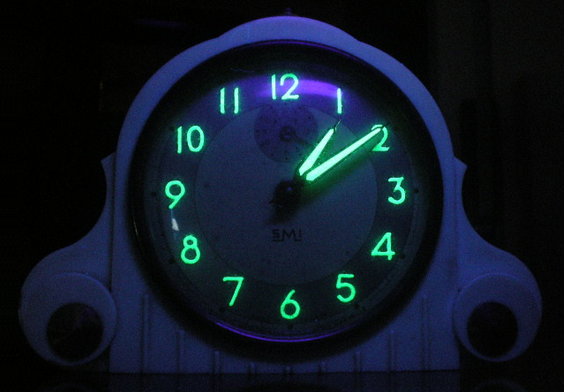September 9, 2020
Jamie Withorne
The following was originally published in Inkstick.
Recently, Madame Marie Skłodowska Curie has been in the spotlight. From the International Atomic Energy Agency announcing an incredible fellowship opportunity in Madame Curie’s honor, to Amazon Videos releasing a film discussing her incredible accomplishments. I will be discussing the latter (kind of).

Clock with a radium dial, Source: WikiMedia Commons
The movie, titled “Radioactive,” is okay. As a nuclear aficionado, I enjoyed the film. But, others? Not so much. One IMBD review labels the film as “an underwhelming biopic of an incredible story.” I am not a film connoisseur, and I won’t pretend to be one here. This piece isn’t meant to be a critique or a review, but rather an observation. Throughout the film, I couldn’t help but notice: there is a lot of green.
In the beginning, there’s some foreshadowing of this reoccurring theme: a single lit green lamp in an aging Madame Curie’s laboratory. The film then flashes back to Marie at a younger age, where she has just begun exploring radioactivity. The next time we really get a “green scene” is when Marie is falling for Pierre Curie, lazing about by a green lake under bright green branches. As the film picks up, so too does this motif. The wallpaper in the Curie’s household? Green. The tint of the laboratory windows as they get closer to discovering radium? Green. The radium itself? Bright, glowing, green.
Throughout the film, as radium continues its development and respective applications, the color green follows. For example, the radioactive chocolate, cigarettes, and beauty powder, “radioactive quackery” products, that initially come in the wake of radium’s discovery all have accents of green. The film also provides snapshots of radium’s future potential. These previews first start happy: a cancer patient circa 1950s receiving treatment in an American hospital (with, you guessed it, green walls). The next preview is decidedly less hopeful, wherein viewers find themselves in the green cockpit of Enola Gay, as American pilots drop the first nuclear weapon, Little Boy, on Hiroshima. Then comes a preview of people watching a nuclear explosion in Nevada, onlookers adorned in green while the mock house that’s eviscerated dons a green interior. At some point, we jump to Chernobyl, melting down and oozing green. As the film comes to an end, we find Curie on the battlefield, outfitting green ambulances with x-ray machines powered by her discovery. She travels through the war-torn terrain, the death and destruction of World War I reflected in her green eyes, a stark juxtaposition to her life-saving achievements.
As Mr. Curie states in the film, “you can’t see radioactivity…” Why, then, is there so. much. green?
Continue reading at Inkstick.
